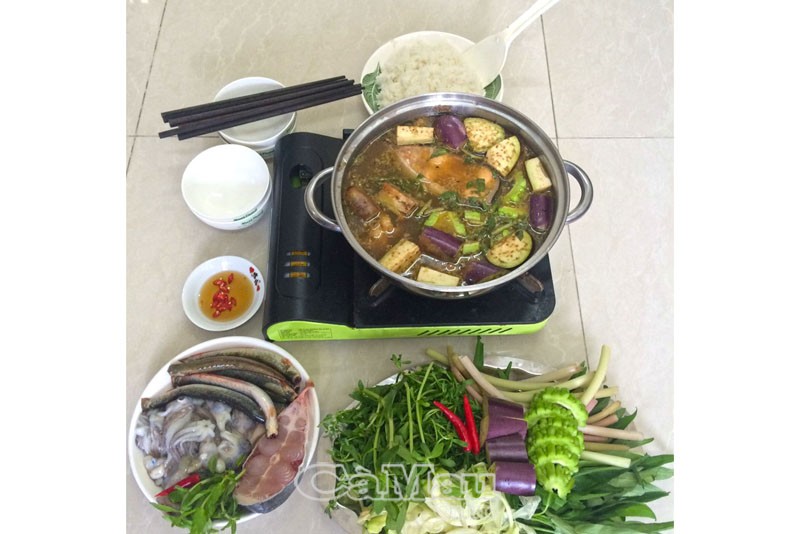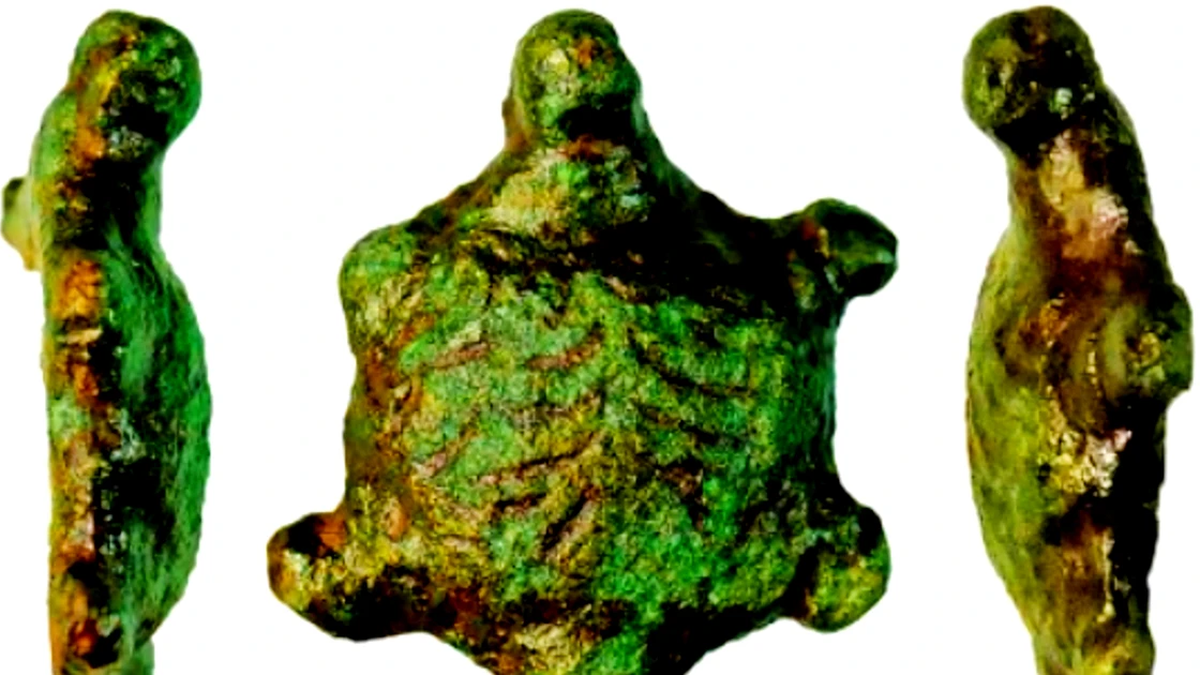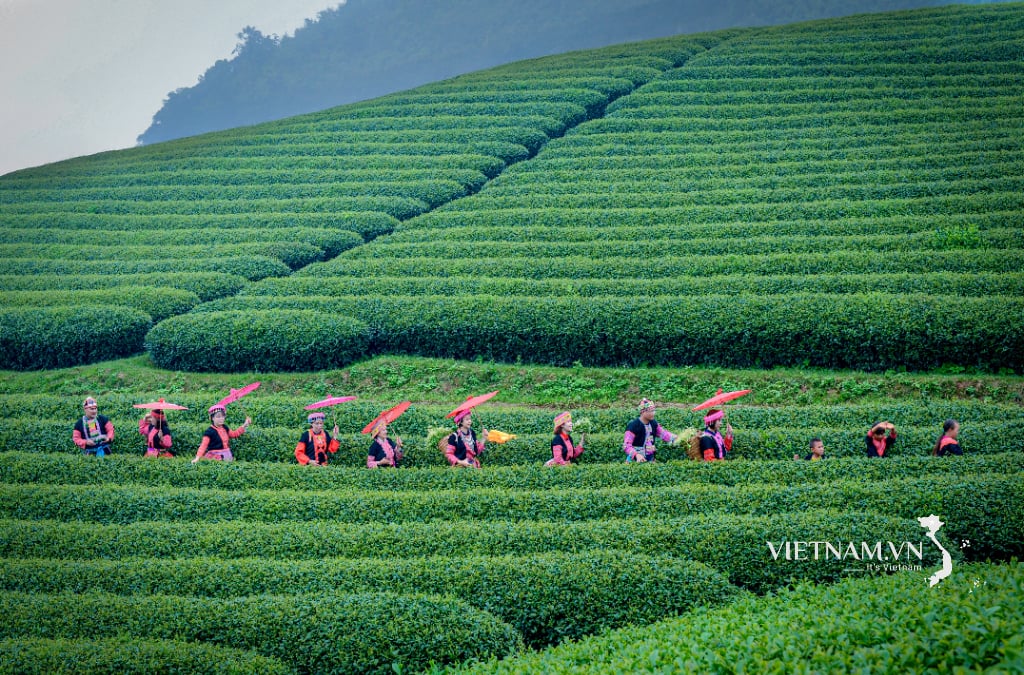It must be called exactly Ca Mau fish sauce, because actually now I know there are many types of fish sauce, different from region to region, to the type of fish used to make the fish sauce. That difference, brings with it the difference in flavor of each type of fish sauce... But for me, nothing can surpass the flavor of the fragrant aroma of fish and marinated rice powder, the rich taste mixed with a bit of natural sweetness of fish that has been marinated for a long time. It is not the sweetness from the sugar, but later when craving, going to a fish sauce hotpot restaurant, ordering a hotpot with full spices, fish, meat added, vegetables of all kinds, both familiar and strange, but eating only makes you full, why doesn't it satisfy your craving...
 |
| Fish sauce hotpot with wild vegetables, a memorable dish! Photo: THANH CHI |
Every time I go back to my hometown, I have to eat a fish sauce meal, braised fish sauce or a fish sauce hotpot, the better. Just need some good fish sauce, some big perch, some shrimp with pork belly, a few eggplants... and available garden vegetables to make a delicious fish sauce hotpot! I also like to eat vermicelli with fish sauce, also known as vermicelli with broth, in town. Many people say that outside Ca Mau city there are many delicious vermicelli with broth restaurants, but I have not had the chance to visit. But eating a bowl of vermicelli with broth in Thoi Binh or Tan Bang town is also to feel the taste of home!
Go home to eat noodle soup
I miss the taste of my poor hometown when I'm far away.
Listen to the rich taste of fish sauce
The soul of the countryside and the hard-working days of parents...
That's how I feel when I go back to my hometown, in the morning I go to town to eat a bowl of noodle soup.
I have been familiar with the taste of fish sauce since I was a child. In the countryside, at that time, every house had a few jars of fish sauce in the house, a little better, in cowhide jars. Mainly fish sauce was snakehead fish, perch fish, and snakehead fish. Fish sauce of large snakehead fish was kept separately, usually to make steamed fish sauce, or to sell at the market at the beginning of the rainy season to have money to buy daily necessities for the house. Because at that time, freshwater fish were rare, and fish sauce was also expensive. Before the rainy season started, it was also the time when the fish in the fields were gone, and only saltwater fish and shrimp remained in the river. Fish sauce was the staple dish of every family in the countryside at that time, and steamed fish sauce was the simplest dish. When the rice boiled, the water was drained, then the bowl or cup of fish sauce was put in, and the lid was closed. Adding a little fat to the fish sauce was even better! Cooked rice also had steamed fish sauce in the rice cooker. How attractive was the fragrant and fatty flavor of the steamed fish sauce. Add a bunch of vegetables or a cucumber and you have a simple country meal. There were days when we had fish, my mother cooked a pot of fish sauce for the whole family. It was simply cooking fish sauce with fish to dip vegetables. Back then, in the countryside, there was no such thing as buying vegetables. Boiled or stir-fried wild vegetables, bitter vegetables, dipped in fish sauce, many people in my hometown still remember it. Of course, I am included!
In the past, when I was in my teens, I carried a machete to the fields to work, clear the grass and plant rice. Most families in the poor countryside at that time worked the fields entirely by hand. Clearing the grass, raking into ridges, clearing the grass again (also called “che”), and then transplanting. Transplanting with “stings” was very manual, unlike transplanting on soft, muddy plowed land like today. Very few families had buffaloes to plow, so clearing, raking, transplanting… during the early rainy season was a normal thing for rural workers in the fields. Every morning when going to the fields, they ate breakfast at home, then brought some for lunch. The main food was still steamed fish sauce. When the transplanting season came, almost every family fed the transplanters steamed fish sauce with pumpkin soup stewed with coconut…
That's just what I've been talking about: two dishes made from fish sauce, steamed fish sauce and braised fish sauce. There's another dish that I only fully appreciated the delicious taste of fish sauce when I grew up. That's raw fish sauce! I like to eat raw fish sauce and when I started drinking, I liked to drink rice wine with raw fish sauce. Raw fish sauce doesn't have to be big. Snakehead fish is about the size of an adult's big toe, while perch is about 2 fingers smaller... Add a little lemon, chili, sugar to perch fish sauce, snakehead fish sauce... Those with good teeth can just bite it like that, small fish sauce should be chewed with the bones, otherwise, slice it. Raw fish sauce is eaten with cold rice, or drinkers can use it as an appetizer with rice wine, eaten with green banana, sour star fruit, pineapple, or coconut shell... there's nothing better! The soul of the countryside is filled with the rustic and familiar flavor of the homeland...
When the rice fields start to turn green from the beginning of the eighth lunar month onwards, it is the season of rice blooming, and also the season of freshwater fish. At that time, the freshwater fish sauce dish begins to gradually disappear from each family’s meals, and is replaced by fish dishes until the end of the year, when the dry season comes.
The last rains of the rainy season are about to end, which is also the peak of the fish season. After the rain, the water in the fields and forests gradually dries up, which is also the "fishing season". After a rainy season, the fish go to the fields and forests... to breed and grow, and when the rain stops and the water dries up, the fish also find their way back to the rivers, canals or garden ponds. In addition to spreading nets, setting hooks, setting traps, setting traps... to catch fish for daily food, the source of fish for making fish sauce only focuses on bailing out ponds and pulling nets.
Many families have several "pond mouths" on their rice fields or adjacent to their gardens. When the water in the fields dries up, the fish just follow the low-lying areas, ponds, or ditches down. There are all kinds of fish in the ponds, both big and small. Every time a family drains the pond, the whole neighborhood comes together to help. Children wait until the pond owner finishes catching fish, then jump in to "catch the fish". Each "pond mouth" usually has a few hundred kilos of fish... Later, people no longer use the method of draining the ponds with buckets to catch fish, but instead switch to using nets to "catch the pond", which is lighter and simpler. On the old canals, such as Canals No. 2, No. 3... near my house, there are also countless fish. During the dry season, when the farming work is finished, my parents often go into those canals to pull the net. Snakehead fish, perch, and snakehead fish... can be caught in the dozens of kilos every day. At that time, the population was sparse but there were many fish, so it was normal to catch a lot of fish with simple fishing tools. Pond fish and net fish were divided into categories. The good fish were put in baskets so that my mother could take them to the market early in the morning to weigh for her customers. The rest were used to make fish sauce, because how could we eat them all?
In the past, although there were many people who had to prepare fish to make fish sauce, I found it simple. When someone had fish, the neighbors would come and help, mainly by gutting and cleaning. The way to scale the fish was very simple. Snakehead fish, perch, and snakehead fish were put into a mortar, then tied together with a reed about the size of an ankle, and pounded. After a while, the fish would be scale-free.
I don’t remember the steps my mother used to take to make fish sauce, but I remember very clearly that fish sauce was usually stored in a sugar jar, covered with areca leaves and tightly sealed. On top was a layer of fish sauce. When the fish sauce was finished, it had to be left to ferment for several months before eating. Each time, a small amount was taken out, enough to eat for a few days, which was called “unloading the fish sauce”. If a large amount was taken out and left for a long time, my mother said the fish sauce would “stink” and lose its taste. Later, I watched people’s instructions on how to make fish sauce online. Some of the ingredients were the same as in the past, but it was certain that the fish sauce jars of those days did not have MSG mixed in, nor did they have pineapple marinated with the fish… Could it be that the flavor of fish sauce today is not as intact as before because of the way it was made? I think that people in the past had integrated and adapted to natural conditions to stabilize their lives from generation to generation. When there were countless fish in the season, they made fish sauce, and when the annual fish season ended, they switched to eating fish sauce, also made from fish. Thus, people are attached to rivers, fields, and enjoy the products that nature gives them flexibly but sparingly.
Nowadays, every time I return to my hometown, even during the season of freshwater fish, it is not easy to find freshwater fish to eat, let alone make fish sauce. Therefore, my people have long since started making fish sauce with all kinds of fish, from goby, tilapia, grass carp and even sea fish. Honestly, all of those types of fish sauce cannot replace the flavor of the freshwater fish sauce made from perch, snakehead fish, snakehead fish... in the fields and rivers of my hometown in the past, creating a specialty of freshwater fish from Ca Mau that I can never forget!./.
Nguyen Song Trem
Source: https://baocamau.vn/nho-sao-huong-vi-mam-dong--a706.html


































































































Comment (0)